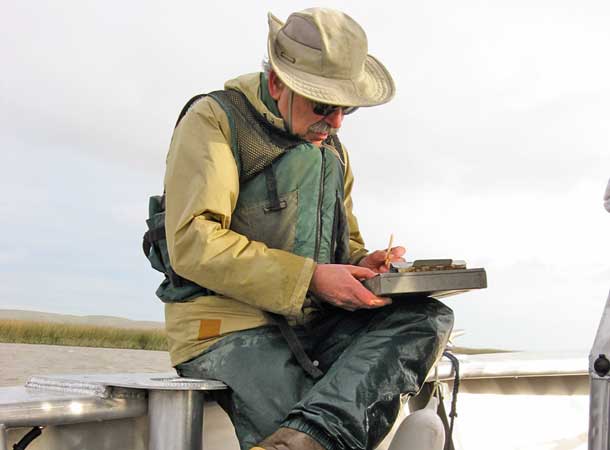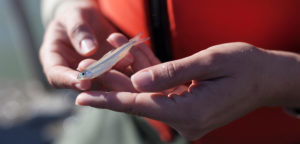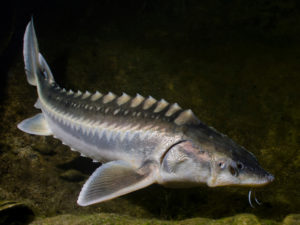On a 21-foot aluminum boat floating in Suisun Marsh, Amanda Schwabe heaves up the otter trawl as Cesar Morales coils the rope on deck. When Schwabe brings up the net, Captain Teejay O’Rear pours its contents into a shallow pan. In bibbed waders provided by UC Davis, O’Rear and three volunteers (myself included) reach into the murky water for Sacramento split tail, striped bass, white sturgeon, and prickly sculpins. We measure the fish on plate-sized rulers before putting them back into the slough, part of the largest wetland complex in the San Francisco Bay-Delta estuary. Today’s data will be added to research done by hundreds of volunteers since prominent fisheries biologist Peter Moyle started the Suisun Marsh Fish Study 33 years ago.
In 1979, Moyle took monthly samples of tule perch in Suisun Marsh for one of his students’ dissertations. “I spent a year messing around — I guess would be a good way to put it — and that allowed me to figure out where to do regular sampling,” says Moyle, associate director of UC Davis’s Center for Watershed Sciences. The California Department of Water Resources (DWR) asked Moyle to continue monitoring fish and has funded the project ever since. “We’ve become one of the seven standard monitoring programs in the estuary,” says Moyle. “Our data is used by people way beyond the Suisun Marsh.”
This monthly sampling at 21 sites within the marsh couldn’t happen without volunteers, says O’Rear, the project’s coordinator since 2008 and a manager at Moyle’s lab. O’Rear draws from a pool of volunteers that includes current and former students, employees at state water and wildlife agencies, and a few outliers like Mike Wigginton, who is close to retiring from the Sacramento Metropolitan Fire District. Wigginton took a marine biology class a few years ago when he returned to school to complete his associates degree and told his professor he wanted to help with research when he retired. That led him to O’Rear. “I really like fish,” said Wigginton, “and I might as well put myself to good use.”
The data has indeed been useful, Moyle says, showing an overall decline of native fish and an increase in non-natives. But there are nuances within the long-term trends: Native fish populations, though dropping, don’t spike or fall as dramatically as those of non-natives, likely because the natives are better adapted to California’s cyclical floods and droughts.
Another discovery came when O’Rear decided to look at the stomach contents of striped bass, a popular game fish introduced in 1879 but lately blamed by some for the precipitous decline of the endangered Delta smelt. After pumping the stomachs of more than 100 fish (a quick procedure that the fish survives), he didn’t find smelt or any other open-water fish the bass normally eat. Instead he found native three-spined stickleback and prickly sculpin. That led to another discovery. “Duck clubs have freshwater ponds and levy ditches filled with vege-tation and small fish,” explains Moyle. “When they drain the ponds, these little fish start pouring out. The striped bass — not being dumb — sit there with their mouths open.” In several individual fish they found hundreds of sticklebacks. “It’s a good example of how water management can alter predator-prey relationships,” says O’Rear.
“Splity!” calls the mutton-chopped O’Rear as I measure another Sacramento split tail. Last year’s rain was good for split tails, large native minnows unique to the estuary. “Just like Delta smelt, they need the estuary to function, and Suisun Marsh is the best place for them,” says Moyle. “They move upstream to spawn in floodplains, and Suisun Marsh is just downstream of the biggest floodplain of all, the Yolo Bypass.”
After finishing the otter trawl, we took a 35-mile-per-hour zip up the main channel for some catch-and-release fishing. A white-tailed kite flew in front us, and six white pelicans sat on shore. In the ebb and flow of the largest contiguous marsh in the western United States, native and nonnative fish now live and breed in nearly equal numbers. In the larger struggle over water exports and habitat restoration, the data collected from this study will continue to play an important role in the debate over the San Francisco Bay-Delta’s future.
Contact Teejay O’Rear (taorear@ucdavis.edu) to volunteer.





